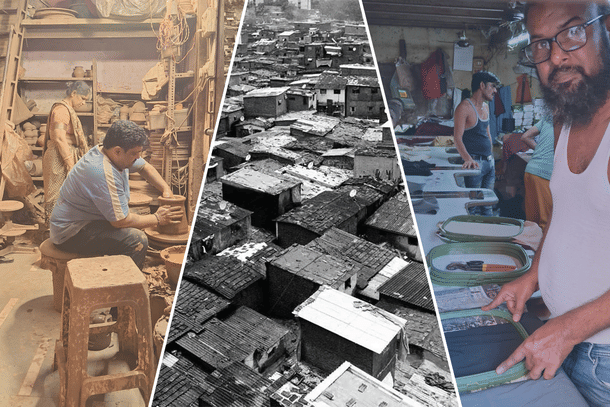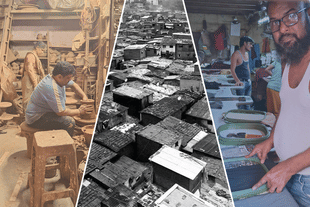Infrastructure
With Fadnavis Returning As CM, The Dharavi Redevelopment Project Can Be Taken To Its Logical And Requisite Conclusion
Swarajya Staff
Dec 04, 2024, 05:23 PM | Updated Dec 06, 2024, 06:10 PM IST
Save & read from anywhere!
Bookmark stories for easy access on any device or the Swarajya app.


The BJP-led Mahayuti coalition’s big win in Maharashtra’s assembly elections is expected to give a fresh push to several projects in the state.
Of these, the Dharavi Redevelopment Project remains key, which has gained new energy with Devendra Fadnavis returning as chief minister.
Before the elections, Dharavi’s redevelopment became a major polling issue. The project, handed over to the Adani Group after years of delays, has drawn significant attention.
Despite some progress, it remains highly sensitive because of its large scale and the direct impact it will have on Dharavi residents, their jobs, and the local economy that has developed there over the years.
Opposition parties and local groups continued to raise strong objections, often accusing the government of political and personal motives.
The Shiv Sena (UBT), in its election manifesto, promised to cancel the Adani Group’s contract and instead proposed building an International Financial Services Centre (IFSC) in Dharavi. They also said they would take back the land given for the redevelopment project.
Former Chief Minister Eknath Shinde criticised these opposition plans, accusing them of blocking progress. “Do they know anything other than stopping projects and delaying development?” he had asked days before voting in Maharashtra, highlighting the poor living conditions in Dharavi.
However, with the election results securing Devendra Fadnavis' leadership, the Dharavi Redevelopment Project is now expected to progress faster.
The Current Status
The Dharavi Redevelopment Project aims to transform Asia's largest slum, spanning 259 hectares and housing approximately 6,00,000 residents and 12,000 businesses, into upgraded housing, commercial spaces, and modern infrastructure.
In 2024, significant progress was finally made, beginning with a detailed survey to identify homes, determine eligibility for rehabilitation, and gather other critical data.
Each household was assigned a unique identifier for a laser-based Lidar survey. Since March 2024, over 25,000 tenements have been surveyed, and more than 60,000 dwellings have been numbered, according to project updates.
In September 2024, the project officially commenced with a small ceremony in Matunga, where the first phase of construction began.
Eligible residents will receive free housing on six acres of railway land allocated in Matunga. To aid the rehabilitation process, additional land parcels outside Dharavi have also been assigned by the state government.
However, as the project progressed, the government had continuously faced hurdles over eligibility surveys, and the allocation of land parcels for rehabilitation outside Dharavi.
Challenges with Eligibility and Rehabilitation
The initial survey also marked a significant number of residents as ‘ineligible’ for rehabilitation within Dharavi.
Dharavi has long been an entry point for low-income groups migrating to Mumbai, providing both affordable housing and small livelihood opportunities.
Over time, the settlement expanded informally, and many structures grew without official regulations.
Despite being informal, these spaces have functioned as both homes and workplaces for countless individuals. The 'ineligible' residents, who will not be provided housing within Dharavi itself, have raised several concerns within the community.
However, with special provisions, they will be relocated to areas within the Mumbai Metropolitan Regions (outside Dharavi).
According to the Slum Rehabilitation Authority (SRA), residents who lived in Dharavi before 2000 qualify for free 350-square-foot homes in the redevelopment area.
Those who moved there between 2000 and 2011 are eligible for 300-square-foot homes in the Mumbai Metropolitan Region (MMR) at a discounted price of Rs 2.5 lakh under the PM Awas Yojana.
Residents who arrived after 2011 are not eligible under SRA rules. For these individuals, affordable rental housing is being planned on additional land.
Moreover, a micro-economy has developed in Dharavi over decades, with industries, workshops, and small businesses, that require special attention during the survey and rehabilitation process.
To address this, 225-square-foot commercial spaces will be provided free of cost to those running the workshops and businesses, with the option to purchase additional space at construction cost, according to the Adani Group.
Rehabilitation Outside Dharavi
The project has also raised concerns among residents in nearby areas designated for relocation.
While most look forward to much-needed redevelopment and the integration of this large area into the city, there are apprehensions among other regions regarding an influx of Dharavi residents.
Kanjur, Bhandup, and Mulund, where land parcels have been designated for rehabilitation, have witnessed protests from residents.
In areas like Mulund and Kurla, residents have expressed concerns about overpopulation, infrastructure strain, and ecological disruption, particularly on salt pan lands.
Allegations from the Opposition Parties
Adding to this, the government’s decision to allocate several key land parcels to facilitate the project, has been seized upon by the opposition as a core issue.
These land allocations include 255 acres of salt pan land in Mumbai, 140 acres at Madh, and, as of October 2024, a cabinet decision to allot over 124.3 acres of Deonar Dumping Yard land to the project.
The Congress has repeatedly criticised the Dharavi redevelopment project, labelling it a “Modani enterprise,” while the Shiv Sena (UBT) took to the streets with protests and press conferences on the issue.
For Locals, the future looks favourable now
Many locals have voiced concerns about the political narratives surrounding the Dharavi redevelopment project, fearing that such debates could delay much-needed improvements to their living conditions.
But with the Mahayuti coalition securing public support again, the outlook on the redevelopment seems more favourable than at any other time.
After multiple delays and nearly two decades of uncertainty over the transformation of Dharavi, it was now under the Shinde-Fadnavis-led Mahayuti government, that the project made significant progress.
Now, with a clear, unambiguous mandate to the Mahayuti, the redevelopment project is expected to move steadily, despite the opposition driven by various interests.
Ultimately, Dharavi's redevelopment could enable the integration of its residents and economy, as well as open up the whole area to Mumbai’s larger population.




